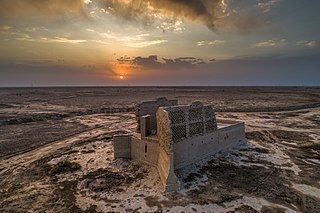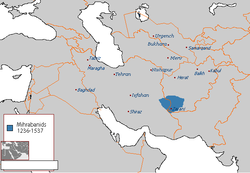
The Saffarid dynasty was a Persianate dynasty of eastern Iranian origin that ruled over parts of Persia, Greater Khorasan, and eastern Makran from 861 to 1002. One of the first indigenous Persian dynasties to emerge after the Islamic conquest, the Saffarid dynasty was part of the Iranian Intermezzo. The dynasty's founder was Ya'qub bin Laith as-Saffar, who was born in 840 in a small town called Karnin (Qarnin), which was located east of Zaranj and west of Bost, in what is now Afghanistan. A native of Sistan and a local ayyār, Ya'qub worked as a coppersmith (ṣaffār) before becoming a warlord. He seized control of the Sistan region and began conquering most of Iran and Afghanistan, as well as parts of Pakistan, Tajikistan and Uzbekistan.
Mahmud is a transliteration of the male Arabic given name محمود, common in most parts of the Islamic world. It comes from the Arabic triconsonantal root Ḥ-M-D, meaning praise, along with Muhammad.

The Kart dynasty, also known as the Kartids, was a Sunni Muslim dynasty of Tajik origin closely related to the Ghurids, that ruled over a large part of Khorasan during the 13th and 14th centuries. Ruling from their capital at Herat and central Khorasan in the Bamyan, they were at first subordinates of Sultan Abul-Fateh Ghiyāṣ-ud-din Muhammad bin Sām, Sultan of the Ghurid Empire, to whom they were related, and then as vassal princes within the Mongol Empire. Upon the fragmentation of the Ilkhanate in 1335, Mu'izz-uddin Husayn ibn Ghiyath-uddin worked to expand his principality. The death of Husayn b. Ghiyath-uddin in 1370 and the invasion of Timur in 1381, ended the Kart dynasty's ambitions.
Shams al-Din is an Arabic personal name or title.

Sistān, also known as Sakastān and Sijistan, is a historical region in present-day south-eastern Iran, south-western Afghanistan and extending across the borders of south-western Pakistan. Mostly corresponding to the then Achaemenid region of Drangiana and extending southwards of the Helmand River not far off from the city of Alexandria in Arachosia. Largely desert, the region is bisected by the Helmand River, the largest river in Afghanistan, which empties into the Hamun Lake that forms part of the border between Iran and Afghanistan.
Shams al-Din 'Ali ibn Mas'ud ibn Khalaf ibn Mihraban was the first Mihrabanid Malik of Sistan. He ruled from 1236 until his death.
Qutb al-Din Muhammad was the Mihrabanid malik of Sistan from 1330 until his death. He was the son of Rukn al-Din Mahmud.
Taj al-Din was the Mihrabanid king (malik) of Sistan from 1346 until 1350. He was the son of Qutb al-Din Muhammad.
Jalal al-Din Mahmud was the Mihrabanid malik of Sistan from 1350 until his death. He was the son of Rukn al-Din Mahmud.
Izz al-Din was the Mihrabanid malik of Sistan from 1352 until 1380. He was the son of Rukn al-Din Mahmud.
Qutb al-Din was the Mihrabanid malik of Sistan from 1380 until 1383. He was the son of Izz al-Din ibn Rukn al-Din Mahmud.
Nusrat al-Din Muhammad was the Mihrabanid malik of Sistan from 1318 until his death. He was the son of Nasir al-Din Muhammad.
Taj al-Din Shah-i Shahan Abu'l Fath or Shah-i-Shahan of Sistan was the Mihrabanid malik of Sistan from 1383 until his death. He was the son of Mas'ud Shihna.
Qutb al-Din Muhammad was the Mihrabanid malik of Sistan from 1403 until his death. He was the son of Shams al-Din Shah 'Ali.
Nasir al-Din Muhammad was the Mihrabanid malik of Sistan from 1261 until his death. He was the son of Mubariz al-Din Abu'l-Fath ibn Mas'ud.
Shams al-Din 'Ali was the Mihrabanid malik of Sistan from 1419 until his death. He was the son of Qutb al-Din Muhammad.
Shams al-Din Muhammad was the Mihrabanid malik of Sistan from 1480 until around the end of the 15th century. He was the eldest son of Nizam al-Din Yahya.
Sultan Mahmud was the last Mihrabanid malik of Sistan from c. 1495 until c. 1537.
Qutb ad-Din or Qutb-ud-Din is an Arabic male given name translated as 'the pivot of the faith' or 'axis of the faith'.

The Nasrid dynasty, also referred to as the Later Saffarids of Seistan or the Maliks of Nimruz, was an Iranian Sunni dynasty that ruled Sistan in the power vacuum left by the collapse of the Ghaznavid Empire and until the Mongol invasion of Central Asia. The Nasrids were a branch of the Saffarid dynasty, and the establishment of the Nasrid Kingdom at Nimruz in 1068 until its dissolution in 1225 represents a transient resurgence of Saffarid rule in Sistan.





